The Compostable Food Trays Market is estimated to be valued at USD 1.8 billion in 2025 and is projected to reach USD 4.1 billion by 2035, registering a compound annual growth rate (CAGR) of 8.5% over the forecast period.
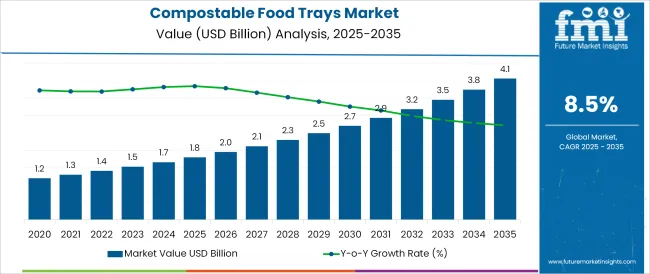
The compostable food trays market is gaining significant momentum as sustainability concerns, evolving consumer preferences, and regulatory pressures converge to reshape the food service packaging landscape. Growing restrictions on single-use plastics and the rising cost of waste disposal have encouraged restaurants, caterers, and institutional buyers to shift toward compostable alternatives.
Industry observations indicate that innovations in materials and manufacturing processes are improving product performance, cost-effectiveness, and availability. The market’s growth trajectory is expected to continue as consumer demand for eco friendly dining options strengthens and food service businesses align more closely with environmental goals.
Strategic initiatives to optimize supply chains and the introduction of durable, aesthetically pleasing designs are creating new opportunities for adoption across diverse end-use environments. The emphasis on closed loop waste management and enhanced composting infrastructure is further paving the path for wider acceptance and market maturity in the coming years.
The market is segmented by Compartment, Material, and End Use and region. By Compartment, the market is divided into Single, 2 to 5, and More than 5. In terms of Material, the market is classified into Bagasse, Kraft Paper, Paperboard, Bamboo, and Others (corn starch, wheat bran, etc.). Based on End Use, the market is segmented into Restaurants, cafe and eateries, Catering services, and Groceries and fresh produce.
Regionally, the market is classified into North America, Latin America, Western Europe, Eastern Europe, Balkan & Baltic Countries, Russia & Belarus, Central Asia, East Asia, South Asia & Pacific, and the Middle East & Africa.
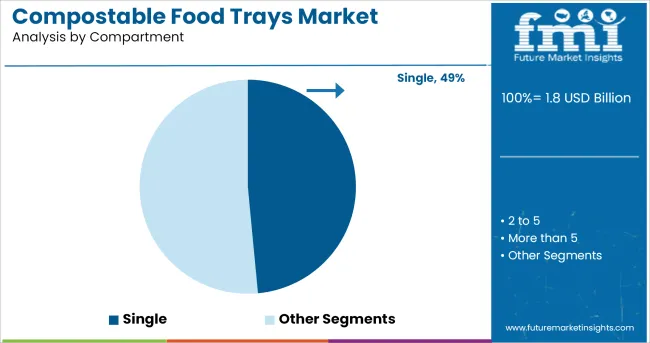
When segmented by compartment, the single compartment segment is expected to account for 48.5% of the total market revenue in 2025, solidifying its position as the leading configuration. This leadership has been driven by its versatility, ease of use, and suitability for a wide range of menu items.
The simplicity of the single compartment design has been preferred by operators aiming to streamline food preparation and reduce material costs without compromising on presentation. Furthermore, its compatibility with automated packing systems and stackability in transport has improved operational efficiency for high volume food service establishments.
These functional advantages have positioned the single compartment tray as the most practical and widely adopted solution, meeting the needs of both quick service and premium dining formats while supporting sustainability objectives.
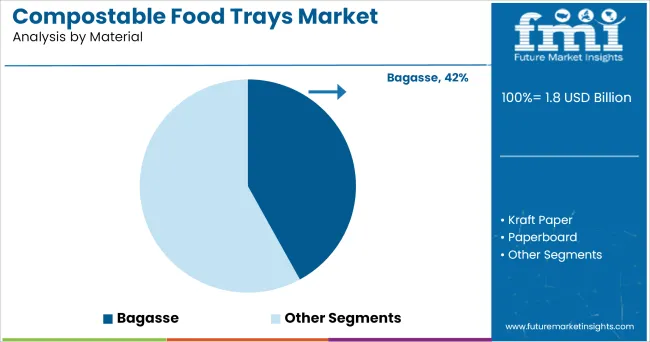
Segmenting by material, bagasse is projected to hold 42.0% of the market revenue in 2025, emerging as the dominant material choice. This prominence has been reinforced by its abundant availability, compostability, and favorable strength to weight ratio compared to alternatives.
Food service operators have increasingly favored bagasse due to its heat resistance, grease tolerance, and natural aesthetic, which aligns with eco conscious branding. The ability of bagasse to biodegrade efficiently in industrial composting facilities has further enhanced its appeal, supporting compliance with local composting mandates.
Its cost competitiveness, driven by advancements in processing technology and stable supply from sugarcane-producing regions, has strengthened its market position. These attributes have enabled bagasse to become the preferred material among environmentally responsible operators seeking to balance sustainability with functional performance.
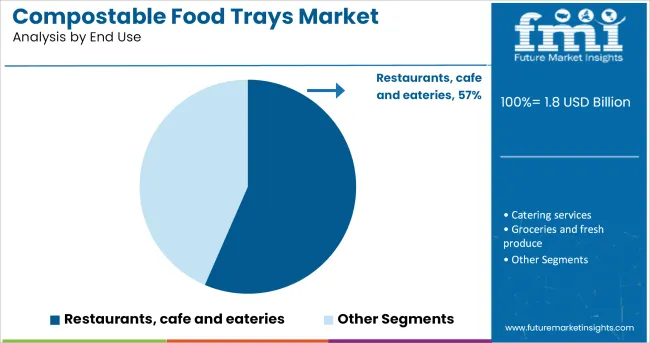
When segmented by end use, restaurants, cafés, and eateries are expected to capture 56.5% of the market revenue in 2025, maintaining their status as the leading customer segment. This dominance has been underpinned by their direct engagement with environmentally aware consumers and the operational pressures to meet regulatory standards.
Food service businesses have widely adopted compostable trays to enhance their brand image, respond to customer expectations for sustainable practices, and comply with bans on non-compostable packaging. The sector’s high transaction volume and need for reliable, attractive, and compliant packaging have driven large scale adoption of compostable trays.
Furthermore, operators have leveraged these products as a differentiator in competitive urban markets, reinforcing loyalty among environmentally conscious diners. The alignment of sustainability initiatives with operational efficiency and customer engagement strategies has ensured that restaurants, cafés, and eateries remain the primary drivers of market demand.
With the rising environmental concern, the preference towards compostable, biodegradable packaging is rising. The compostable food trays are made of eco-friendly and renewable plant fibres such as bamboo, pulp leftover from sugarcane (bagasse), corn starch, wheat bran, palm leaves, coconut coir, Kraft paper, etc.
They are eco-friendly, bio-degradable, and compostable, do not contain harmful chemicals, and do not contaminate the food. These compostable food trays have an elegant look, and they are sturdy, durable, break-proof, and crack-proof properties. These compostable food trays are microwave-safe, and freezer friendly; therefore, they can be used for hot and cold food packaging.
Additionally, they accommodate light, heavy, liquid, or solid food products confidently. The food trays locking system ensures no leakages, spillages, therefore considered as the most convenient food packaging.
These compostable food trays are made from plant fibre or wood pulp, which can be disposed of naturally without harming the environment; hence these environment-friendly compostable food trays market will have exponential growth in coming years.
The compostable food tray is a premium quality natural container made from sustainable and renewable plant fibre without plastic. Compostable food packaging is gaining importance due to growing environmental concerns and consumers’ preference for eco-friendly and sustainable products.
Various countries are not restricting the use of plastic packaging due to its harmful effects on the environment. Hence the compostable food trays market is anticipated a significant demand. Additionally, the compostable food trays with partitions keep the food products separate, easy and convenient for eating. Food trays with separate compartments keep the food products apart and do not get mixed up and messy.
Therefore, it becomes suitable for hotels and restaurants to pack the food properly.
Furthermore, with the rising trend towards outings, picnics, and family get-togethers, compostable food trays are considered the best option due to their ease of carrying and disposing of properties. The compostable food trays are also widely used during corporate events, office meetings, big parties, and social functions as the most suitable and sustainable packaging solution.
Thus, the demand for the compostable food trays market is anticipated to witness significant growth.
Nowadays, the trend towards readymade food orders and ready-to-eat food ordering is popularizing tremendously due to increasing working hours, busy lifestyles, and income growth of middle-class families. The rising awareness towards healthy food consumption and preference towards natural organic food packaging generates massive demand for compostable food trays.
Hence, compostable food trays, with their features of protecting the food from spoilage during transportation, keeping the food products fresh and safe, maintaining nutritional value, and food quality, is expected to augment the growth of compostable food trays.
The vision towards a more sustainable packaging solution and rigorous efforts of the manufacturers towards technological advancement, continuous research, and development process to produce more environment-friendly compostable food trays without any adverse effect on nature could create an ample opportunity for compostable food trays in the near future.
The compostable food trays prices are the biggest challenge. The cost of the compostable food trays is much higher than regular conventional food packaging products; therefore, the layman cannot afford to purchase the same very often.
Even the various food packaging compliances and stringent rules and regulations regarding the manufacturing processes and specific disposable guidelines adversely affect the key manufacturers. Additionally, the recycling and disposing costs and poor infrastructure also lead to lower demand for compostable food trays.
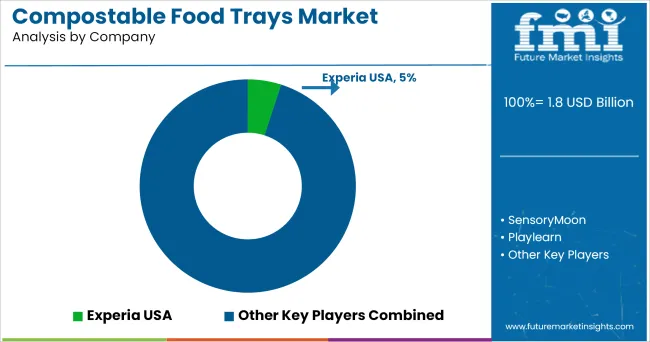
Key players such as:
are actively involved in compostable food trays market for different applications.
Key Asian players such as:
are actively involved in compostable food trays market for different applications.
The manufacturers involved in manufacturing compostable food trays adopt various strategies such as innovation and product launch, focusing on sustainability to serve the increasing demand for the compostable food trays market.
Huhtamaki Oyj has developed economical molded fibre SAVADAY® tray for environmentally conscious users. The tray is made from 100% recycled material and is 100% compostable.
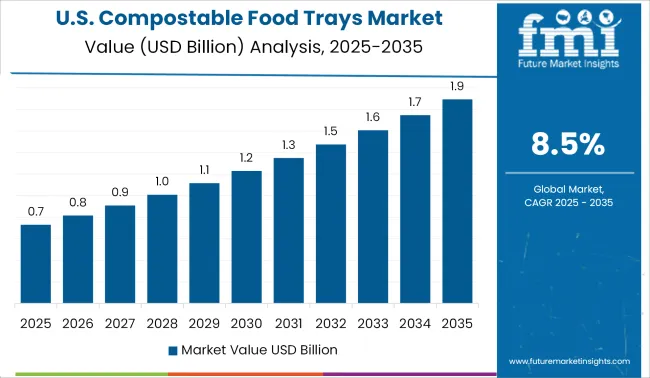
The trend of fast-food restaurants, take-out shops, readymade or ready-to-eat food packages, meals-to-go, and food trucks is growing extensively in USA Due to a fast and busy lifestyle and convenience, the preference towards food ordering is rising remarkably. The USA is a developed country, and the people are very much concerned about naturally-grown and organic products consumption due to environmental protection.
Therefore the customer’s choice of high-quality food packaging with elegant, eco-friendly, and sustainable functionality drives the compostable food trays market in the United States. Various NGOs and the Government are promoting the use of bio-degradable, recyclable and compostable food products.
FDA-approved food-grade disposable compostable, eco-friendly, carbon-neutral, renewable resource food packaging trays are expecting an overwhelming demand in recent years in the United States.
The global compostable food trays market is estimated to be valued at USD 1.8 billion in 2025.
The market size for the compostable food trays market is projected to reach USD 4.1 billion by 2035.
The compostable food trays market is expected to grow at a 8.5% CAGR between 2025 and 2035.
The key product types in compostable food trays market are single, 2 to 5 and more than 5.
In terms of material, bagasse segment to command 42.0% share in the compostable food trays market in 2025.






Our Research Products

The "Full Research Suite" delivers actionable market intel, deep dives on markets or technologies, so clients act faster, cut risk, and unlock growth.

The Leaderboard benchmarks and ranks top vendors, classifying them as Established Leaders, Leading Challengers, or Disruptors & Challengers.

Locates where complements amplify value and substitutes erode it, forecasting net impact by horizon

We deliver granular, decision-grade intel: market sizing, 5-year forecasts, pricing, adoption, usage, revenue, and operational KPIs—plus competitor tracking, regulation, and value chains—across 60 countries broadly.

Spot the shifts before they hit your P&L. We track inflection points, adoption curves, pricing moves, and ecosystem plays to show where demand is heading, why it is changing, and what to do next across high-growth markets and disruptive tech

Real-time reads of user behavior. We track shifting priorities, perceptions of today’s and next-gen services, and provider experience, then pace how fast tech moves from trial to adoption, blending buyer, consumer, and channel inputs with social signals (#WhySwitch, #UX).

Partner with our analyst team to build a custom report designed around your business priorities. From analysing market trends to assessing competitors or crafting bespoke datasets, we tailor insights to your needs.
Supplier Intelligence
Discovery & Profiling
Capacity & Footprint
Performance & Risk
Compliance & Governance
Commercial Readiness
Who Supplies Whom
Scorecards & Shortlists
Playbooks & Docs
Category Intelligence
Definition & Scope
Demand & Use Cases
Cost Drivers
Market Structure
Supply Chain Map
Trade & Policy
Operating Norms
Deliverables
Buyer Intelligence
Account Basics
Spend & Scope
Procurement Model
Vendor Requirements
Terms & Policies
Entry Strategy
Pain Points & Triggers
Outputs
Pricing Analysis
Benchmarks
Trends
Should-Cost
Indexation
Landed Cost
Commercial Terms
Deliverables
Brand Analysis
Positioning & Value Prop
Share & Presence
Customer Evidence
Go-to-Market
Digital & Reputation
Compliance & Trust
KPIs & Gaps
Outputs
Full Research Suite comprises of:
Market outlook & trends analysis
Interviews & case studies
Strategic recommendations
Vendor profiles & capabilities analysis
5-year forecasts
8 regions and 60+ country-level data splits
Market segment data splits
12 months of continuous data updates
DELIVERED AS:
PDF EXCEL ONLINE
Market Positioning & Share in the Compostable Food Trays Industry
Key Companies & Market Share in the Food Trays Sector
Compostable Foodservice Packaging Market Size and Share Forecast Outlook 2025 to 2035
Market Share Insights of Compostable Foodservice Packaging Providers
PET Food Trays Market Size and Share Forecast Outlook 2025 to 2035
Food Partition Trays Market
Demand for Compostable Foodservice Packaging in Japan Size and Share Forecast Outlook 2025 to 2035
Compostable Pouch Market Size and Share Forecast Outlook 2025 to 2035
Food & Beverage OEE Software Market Size and Share Forecast Outlook 2025 to 2035
Food Grade Crosslinked Polyvinylpolypyrrolidone (PVPP) Market Size and Share Forecast Outlook 2025 to 2035
Food Grade Cassia Gum Powder Market Size and Share Forecast Outlook 2025 to 2035
Food Grade Dry Film Lubricant Market Size and Share Forecast Outlook 2025 to 2035
Foodservice Equipment Market Analysis - Size, Share, and Forecast Outlook 2025 to 2035
Food Basket Market Forecast and Outlook 2025 to 2035
Food Grade Tremella Polysaccharide Market Size and Share Forecast Outlook 2025 to 2035
Food Sorting Machine Market Size and Share Forecast Outlook 2025 to 2035
Foodservice Paper Bag Market Size and Share Forecast Outlook 2025 to 2035
Food Stabilizers Market Size and Share Forecast Outlook 2025 to 2035
Food Packaging Film Market Size and Share Forecast Outlook 2025 to 2035
Food Certification Market Size and Share Forecast Outlook 2025 to 2035

Thank you!
You will receive an email from our Business Development Manager. Please be sure to check your SPAM/JUNK folder too.
Chat With
MaRIA